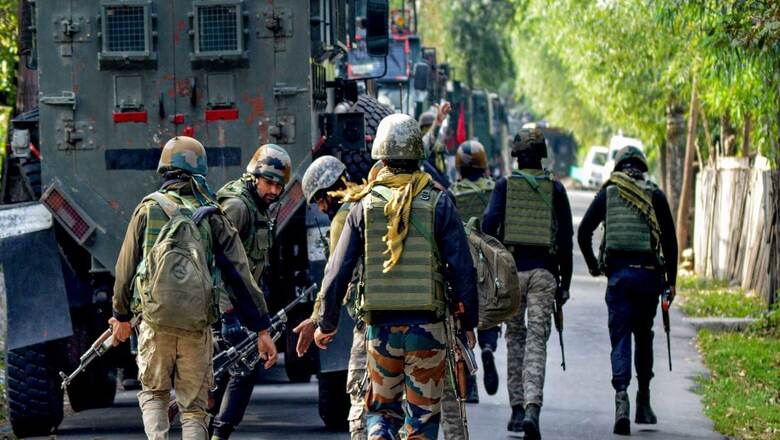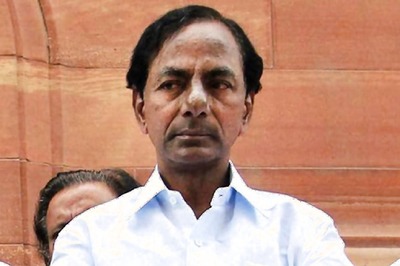
views
The large-scale surprise attack by Hamas terrorists from Gaza on Israel on October 7, 2023, left hundreds of Israelis dead, and many more injured. Very significant numbers, including a few Israeli soldiers were taken hostage. Israel responded promptly with retaliatory Israeli airstrikes followed by a formal declaration of war. The Hamas terrorists have held-off longer than expected. There have been a large number of casualties on both sides and numbers continue to increase.
The Attack
Around 6:30 am on Saturday, Israel was woken up with air raid sirens as rockets flew over Israel. Hamas terrorists from Gaza entered Israel by land, sea and air. The assault coincided with the 50th anniversary of the 1973 Yom Kippur war that began on the holiest day in the Jewish calendar, on October 6, 1973. The Israeli Defence Forces (IDF) said around 2,200 rockets were fired at Israel. The IDF published the names of 44 soldiers who were killed in the attack. Over 200 Israeli civilians were massacred at the Supernova music festival. Hamas claimed to have fired 5,000 rockets, and its leadership said that the attack was a response to the desecration of the al-Aqsa mosque in Jerusalem and the ongoing siege of Gaza.
The al-Aqsa is one of the most revered places in Islam and Judaism. Muslims call it Al Haram Al Sharif (Noble Sanctuary) and Jews as Temple Mount. The complex lies in East Jerusalem, which the Palestinians want as the capital of their future state. It has been a flashpoint of tensions for decades. Hamas terrorists were continuing to operate within Israel as of Monday morning.
Israeli Response
Israeli Prime Minister Benjamin Netanyahu said that Israel will “exact a huge price” from the group. The IDF said it struck 426 targets in Gaza, including 10 towers that it said were used by Hamas. The Israeli Air Force was in action and the videos showed loud explosions and rising plumes of black smoke. Over 300 Palestinians were killed in the first 24 hours, and around 1,900 were injured. As Lebanon’s Iran-backed Hezbollah group also targeted a few Israeli sites using artillery, it invoked Israel military response.
Clashes also broke out in the Israeli-occupied West Bank, after Israel blocked West Bank cities. The IDF is first focusing on clearing the intruders and killing all the terrorists in Israeli territory. Next they plan to take control of the Gaza Strip. The strip has been blockaded from all directions. Water and electricity and other utilities have been cut. Decision for land offensive has still to be taken. Israel too has a large number of Hamas hostages. Some form of exchange may be worked out.
Heightened Recent Tension
Historic differences between the two sides are well known. Hamas is an Islamist outfit with a terrorist wing that came into being in 1987, emerging out of the Muslim Brotherhood, a Sunni Islamist group. Hamas believes that Israel is an occupying power and that it is trying to liberate the Palestinian territories. Hamas has over the years made many attacks on Israel and has been designated as a terrorist organization by the United States, the European Union and Israel.
After Hamas seized control of Gaza, Israel and Egypt imposed a strict siege on the territory, which is ongoing. Israel also maintains an air and naval blockade on Gaza. The last war between Hamas and Israel was in 2021, for 11 days. Nearly 250 were killed in Gaza and 13 in Israel. Israeli police raided the al-Aqsa mosque compound several times over the last year. The number of Palestinians killed in the last year in the occupied West Bank by Israeli forces has been highest in nearly two decades. Same has been the case with Israelis killed in Palestinian attacks.
Global Reactions
West has condemned the Hamas attack and pledged support for Israel. US sends aircraft carrier group to eastern Mediterranean in response to Hamas attack on Israel. The Arab states, including those that have recognized Israel, called for calm. Saudi Arabia, which has been trying to normalise relations with Israel, called on both sides to stop escalation. Iran has congratulated the Palestinian fighters and said they will stand by their side until the liberation of Palestine and holy Jerusalem. Hezbollah (the “Party of God”), a Lebanon-based Shia terrorist group, praised the assault.
Likely Emerging Situation
A “special security situation” area, within an 80-kilometer radius of the Gaza Strip, has already been established. Taking control of Gaza will enable the IDF to provide security instructions to civilians and to close public sites as needed for security. Hamas claims to be ready for all options, including a full war.
The world is trying to prevent a full war that could risk engulfing the region. Brent crude oil prices surged over 5 percent early on Monday amid worsening political instability in the Middle East due to the Israel Hamas war. The ground offensive into Gaza could mean an extended war, and loss of more lives. As long as the neighbouring nations do not come in, the conflict could remain localised. Israel will want to punish Hamas and decapitate them. What level will be enough, time will tell.
Initial Lessons for India
For such a large-scale attack to take place there would have been a lot of planning. Mossad, the national intelligence agency of Israel, is considered to be among the best. The fact that both Mossad and IDF failed to anticipate or prevent such an attack amounts to an intelligence failure. Hamas could not have accumulated 5,000 rockets overnight. The capability to fire 5,000 rockets in 24 hours, something that Hamas in the past could not do even in many weeks of conflict, would have meant training and planning. Importance of human and electronic intelligence has again been underscored.
India must learn never to let its guard down. There should be no let-up when it comes to cross-border terrorism in Kashmir or intelligence on possible bomb-blast anywhere in the country. Large political gatherings in the run up to elections and on special religious events are high-risk areas. Intelligence had failed us in Kargil. India must remain ahead of the adversary.
Multiple asymmetric threats from multiple directions have to be catered for. Kamikaze drones and drone-swarms, though not used in this attack, can cause significant damage. Terrorists using para-gliders have to be factored. India must prepare for a combination of asymmetric threats. It must also cater for the enemy sleeper-cells within and also monitor their supporters abroad. These must be watched closely.
The Israeli government’s strong resolve and political will has been visible through decades. Did the enemy take advantage of the ongoing anti-government protests? Were the security agencies and bureaucracy also politically divided? What about the border police? Should India de-politicise the police? Indian politicians have to be well informed and educated on security matters. Israeli opposition parties have rallied together after the attack. There has to be complete unanimity on foreign policy and security issues. Politicians must be careful and conscious about military morale on what they say. No Israeli has talked about intelligence failure. This can be sorted out later. National security should not be politicised.
Social media has become a big factor. Citizen journalists are growing. Information warfare impacts both tactical appreciation and morale. Cyber snooping is important. This needs close coordination between the security establishment, civilian professionals, and the influencers.
Threat evaluation is a dynamic process. Intelligence gathering must be all pervasive. It has to be continuous, without break. Political leadership has to be in full picture. India has to cater for both state and non-state threats and combinations there on. India must have response options ready for such eventualities. Also capability building is a continuous effort. This is a deliberate activity that also requires funding. Punitive capability has to be visible, and even advertised, so that it can act as deterrence.
Technology must be used extensively for border management. Day and night cameras, thermal imaging, electronic fences, motion sensors are required. Drones for surveillance are important. India must be prepared for simultaneous cyber-attacks. There is a need to build electronic redundancy. Vantage points of space and air must be exploited for intelligence and surveillance.
Terrorism is a scourge that has to be weeded out for ever. There has to be no compromise. There has to be no soft pedaling. Political conditions must be created to general balanced wellbeing of all sections, but militancy must be unacceptable and dealt with full force. There has to be ‘zero tolerance for terror”.
India has seen for long that each battle is India’s own. India has to defend itself on its own, and not expect much external help. Trigger events can happen at short notice. Military capability, training, and weapon stocking has to be in place at all times. Air defence capability against a barrage of missile and rocket attacks, and also drones are important. Security is an all of nation, system-of-systems approach. It has to be handled unitedly. It is time for India to revisit higher defence management. The masses have also to be made conscious and aware. Last but not the least, ‘aatmanirbharta’ in defence is very important.
The writer is Director General, Centre for Air Power Studies. Views expressed in the above piece are personal and solely that of the author. They do not necessarily reflect News18’s views.


















Comments
0 comment